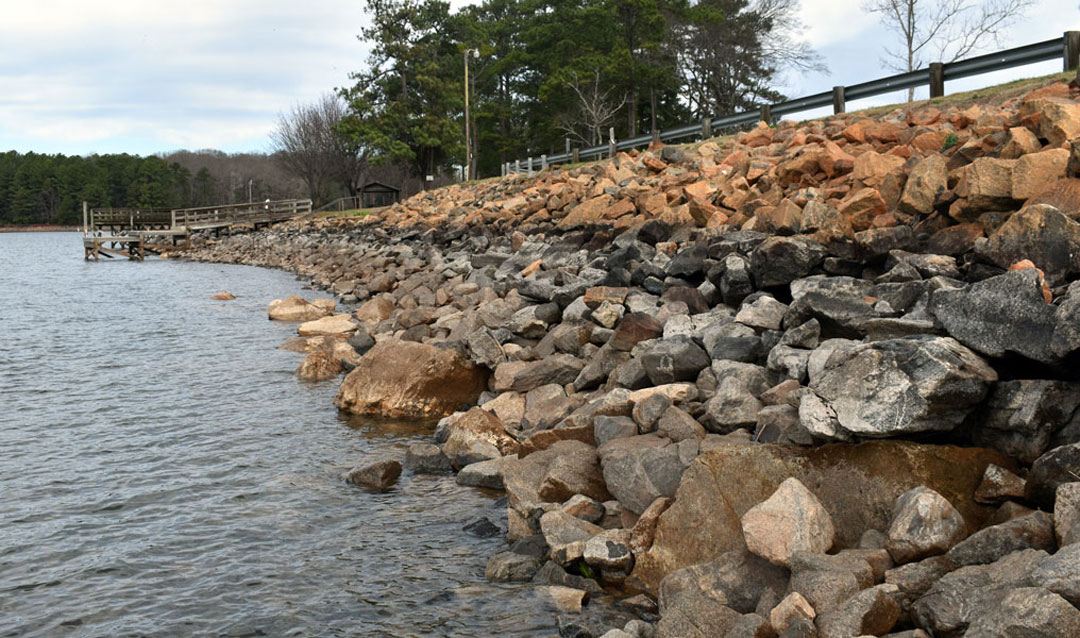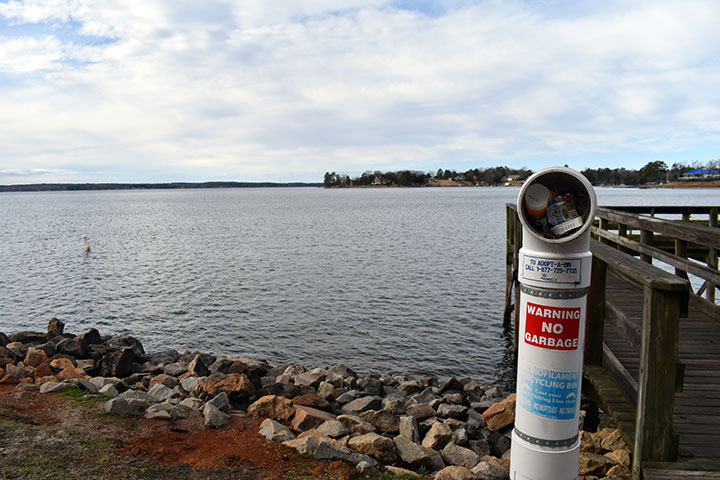The usual water level, signified by the difference in rock coloration, and current water level on the shoreline of Lake Murray (Photos by Abigail Foncannon)
Lake Murray’s water levels are starting to rise again after Dominion Energy lowered the lake’s elevation in the fall.
The drawdown began in October of last year in part to kill pesky vegetation and help improve the lake’s health and maintain water quality. But it’s not without inconveniences for boat owners.
Dominion Energy, as the owner of Lake Murray, is responsible for keeping the man-made lake clean for drinking water, visitors and homeowners.
The company brings down the lake every three to four years, said Dominion Energy spokesperson Matt Long. The last time the water levels were lowered was 2018.
Dominion Energy consulted with the S.C. Department of Natural Resources on the drawdown.
Lower water levels help reduce unwanted vegetation by allowing the area to dry out and freeze if the temperatures are low enough, said Julie Holling, DNR’s program manager for the Aquatic Nuisance Species Program.
“Some of the sediment along the edge is moved into the deeper waters, and the exposed soil is dried out and compacted,” Holling said. “This reduces the ‘mucky’ feel of the bottom and also ties up some of the soil nutrients, so they aren’t as easily available to plants or algae.”
Lake Murray has its fair share of problematic vegetation. The culprits are Illinois pondweed, slender naiad and eelgrass – each of which are native plant species.
“These are good for fishing but have grown enough to cause problems for boaters and people wanting to swim near the shore,” Holling said. “There have also been some algae issues in some of the shallower coves, which caused some taste and odor issues in the local drinking water.”
The lake is one of the main water suppliers for Columbia and pumps an average of 30 million gallons of water a day, city records show.
“The drawdown should help with all of these issues,” Holling said. “But we won’t know how effective it was until the water is back up to full pool and it warms up enough for vegetation to start growing again.”
Dominion dropped lake levels from 358 feet to 350 feet. Levels are expected to rise to normal by late spring.
Getting back to that elevation is dependent on the rainfall and river flows.
Dominion will check lake conditions this summer to see if the vegetation is less prevalent than it was before the drawdown.
Long-term homeowners and visitors have dealt with drawdowns before and have had to make some adjustments.
“It is a little harder to navigate in the bigger waters since the drawdown,” said Lindsey Rackliffe, the publisher of Lake Murray Homeowners Facebook page and a lifelong lake resident. “Shoal markers get moved, so you have to be more focused and pay attention. Many homeowners have to pull their boats out of the water completely, or some will just leave them beached on land until the water comes back up.”
Some homeowners are taking advantage of the drawdown to repair their docks and pilings that couldn’t have been fixed otherwise.
“I needed to see the structure that I can never see,” said Bill Burns, a lake homeowner who is experiencing the drop for the first time.
Homeowners can help reduce the nutrient load in the lake by limiting the fertilizer in their lawns, avoiding fertilizing right before a heavy rain and not feeding the lake’s ducks and geese.
And planting native vegetation along a home’s shoreline can absorb some of the nutrients coming off yards to reduce bank erosion.
“Dominion Energy does a great job with their stewardship of Lake Murray,” said Micah Decker, vice president of marketing for the Capital City/Lake Murray Country Regional Tourism Board. “Our lake is known as a top Southern destination for fishing and outdoor recreation, where visitors and locals alike delight in the clean, clear water.”






